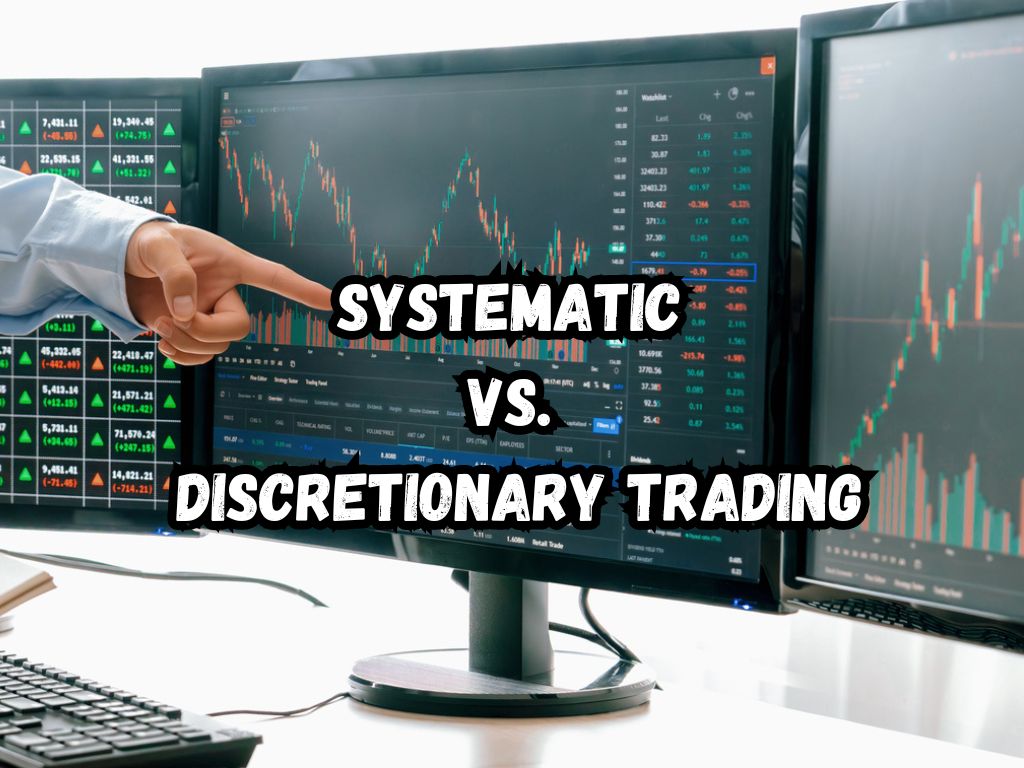In the realm of trading and investment, the debate between systematic and discretionary trading frequently surfaces. Each approach carries its unique characteristics, benefits, and drawbacks.
Understanding the differences between systematic vs discretionary trading to carve a path that aligns with their investment goals, risk tolerance, and market outlook.
Understanding Systematic Trading
Systematic trading, often rooted in quantitative analysis, leverages mathematical models to make trading decisions.
The key here is the removal of human emotion from the trading process, aiming for a disciplined and consistent strategy.
Definition and Core Principles
Systematic trading relies on predefined rules for entry, exit, and money management.
This method involves the use of algorithms that execute trades based on technical indicators or complex mathematical models.

Advantages
One of the main advantages of systematic trading is its emotionless nature. By sticking to predefined rules, traders can avoid emotional decisions that might lead to poor outcomes.
Additionally, systematic strategies can be backtested on historical data, providing a sense of their potential effectiveness in real market conditions.
Disadvantages
However, the rigidity of systematic trading can also be a limitation. Markets are dynamic, and a model that performs well in one market condition may struggle in another.
Furthermore, over-reliance on backtested results might lead to false confidence, as past performance does not guarantee future results.
Key Tools and Strategies
Common tools for systematic traders include trading platforms that support algorithmic trading, like MetaTrader, and strategies such as trend following and mean reversion.
Understanding Discretionary Trading
Discretionary trading stands on the other side of the spectrum. This approach prioritizes trader intuition, fundamental analysis, and the flexibility to adapt to changing market conditions.
Definition and Core Principles
Discretionary trading is defined by the absence of strict trading rules. Instead, traders use their knowledge, experience, and judgment to make decisions on a case-by-case basis.
Advantages
The flexibility of discretionary trading allows traders to adapt strategies as market conditions change. Experienced traders can leverage their understanding of market nuances that aren’t easily quantified in a systematic model.
Disadvantages
However, the discretionary approach is susceptible to emotional biases. Also, the success of this method heavily relies on the trader’s skill and experience, potentially leading to inconsistent results for those less seasoned.
Key Tools and Strategies
Discretionary traders often employ charting software and engage in technical and fundamental analysis to inform their trading decisions.
Systematic Vs Discretionary Trading
Key Differences
The principal difference between systematic and discretionary trading lies in their approach to decision-making. Systematic trading is rules-based and automated, whereas discretionary trading is flexible and judgment-based.
Suitable Scenarios for Each
Systematic trading might suit those who prefer a data-driven approach and have the resources to develop and test models. Discretionary trading, on the other hand, might appeal to those with a deep understanding of markets and a desire for flexibility.
Hybrid Approaches
Some traders adopt a hybrid approach, applying systematic models to identify opportunities while using discretion in executing trades.
This method tries to capture the best of both worlds.

How to Choose Between Systematic and Discretionary Trading
Assessment of Personal Trading Style and Goals
Choosing between systematic and discretionary trading starts with a self-assessment of your trading style, goals, and resources.
Consider your strengths, whether in data analysis or market intuition, and align your choice accordingly.
Risk Management Considerations
Both approaches require robust risk management strategies. Set clear risk parameters to protect your capital, regardless of the trading method.
Resource Availability
Consider the resources you have at your disposal, including time, capital, and expertise.
Systematic trading often demands substantial initial research and setup, while discretionary trading requires ongoing market analysis and adaptability.
Pro Tips for Traders
- Document your trading plan. Whether systematic or discretionary, having a written plan helps maintain discipline.
- Commit to continuous learning. Markets evolve, requiring traders to update their knowledge and strategies continually.
- Pay attention to the psychological aspect. Trading involves stress and risk; managing your mindset is crucial for long-term success.
Frequently Asked Questions
Can a novice trader start with systematic trading?
Yes, novice traders can start with systematic trading, especially if they have a strong interest in data analysis and programming. However, developing and testing a reliable trading model can be challenging and requires dedication.
How does one measure success in discretionary trading?
Success in discretionary trading can be measured by consistent profitability and the ability to adapt to various market conditions without compromising risk management principles.
What are the key risk management techniques for systematic traders?
Systematic traders often use stop-loss orders, position sizing, and diversification across different assets and strategies to manage risk.
How much capital is needed to start with discretionary trading?
The required capital depends on the market and broker requirements. Discretionary trading can be started with relatively small capital, especially in markets that offer low entry barriers and high leverage.
Is it possible to switch from discretionary to systematic trading or vice versa?
Yes, traders can switch between approaches. However, transitioning requires a new set of skills and adjustments to one’s trading plan and risk management strategies.
Conclusion
Choosing between systematic and discretionary trading is not a matter of right or wrong but finding the approach that best matches your personality, resources, and goals.
Both styles have their merits and can lead to successful trading outcomes when applied correctly. Understanding your preferences and market dynamics is key to navigating the complex world of trading.


 Tags:
Tags:










